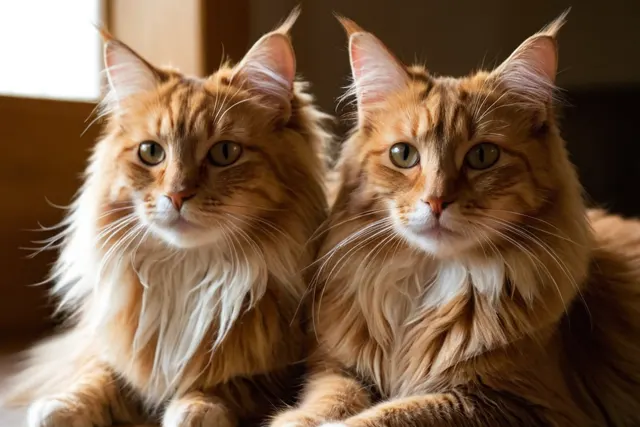



One of the best ways to prevent knots in long-haired cats is to regularly brush their coat. Brushing helps to remove loose hair and prevent it from tangling and forming mats. It is recommended to brush your cat at least once a week, but for cats with thicker coats, daily brushing may be necessary.
When brushing your cat, make sure to use a brush with soft bristles that won't irritate their skin. Start by gently brushing the fur in the direction of hair growth, and then go against the grain to remove any tangles or knots. Be patient and gentle, especially if your cat is not used to being brushed.
If you notice any knots or tangles in your cat's fur, using a wide-toothed comb can help to gently tease them out. Start by holding the fur close to the skin and combing through the ends of the hair. Slowly work your way up, being careful not to pull or tug on the fur.
Using a wide-toothed comb is especially useful for cats with longer hair, as it helps to prevent breakage and damage to the hair shaft. It is important to be patient and take your time when combing out knots, as rushing can cause discomfort or pain for your cat.
For cats with thick undercoats, using an undercoat comb can be beneficial in preventing knots and mats. These combs are designed to remove loose hair and tangles from the undercoat, which can help to prevent them from becoming larger knots.
When using an undercoat comb, make sure to comb through the fur in small sections, starting from the roots and working your way out. Be gentle and avoid pulling or tugging on the fur, as this can cause discomfort for your cat.
If regular brushing and combing doesn't work to remove knots, you may need to use a mat comb or razor comb. These tools are specifically designed to cut through knots and mats, making it easier to remove them from your cat's fur.
When using a mat comb or razor comb, it is important to be extremely careful and gentle. Start by holding the fur close to the skin and carefully cut through the knot or mat. Take your time and work slowly to avoid accidentally cutting your cat's skin.
If all else fails and the knots are too severe to remove with a comb or mat comb, clippers may be used as a last resort. However, it is highly recommended to have a professional groomer do this, as using clippers incorrectly can cause injury to your cat's skin.
If you do decide to use clippers, make sure to use ones that are specifically designed for pets and have a guard to prevent the blades from cutting too close to the skin. Take your time and be extra cautious when using clippers, as your cat's skin is delicate and can easily be injured.
While it may be tempting to use scissors to cut out knots, it is best to avoid doing so. Scissors can easily slip and accidentally cut your cat's skin, causing pain and potential injury.
If you do find yourself in a situation where you need to cut out a knot, it is recommended to use a mat comb or razor comb instead. These tools are designed to safely cut through knots without the risk of injuring your cat.
If you accidentally cut your cat while trying to remove a knot, it is important to clean and treat the wound properly. Start by rinsing the wound with warm water to remove any dirt or debris. You can also use a diluted hydrogen peroxide solution to disinfect the wound.
If the wound is deep or bleeding heavily, it is recommended to seek veterinary help immediately. Your vet can assess the wound and provide appropriate treatment to prevent infection and promote healing.
One of the best ways to prevent knots and mats in your cat's fur is to regularly check their coat for any tangles or knots. By catching them early, you can prevent them from becoming larger and more difficult to remove.
Take the time to gently run your fingers through your cat's fur, paying close attention to areas that are prone to matting, such as behind the ears, under the armpits, and around the tail. If you feel any tangles or knots, use a comb or mat comb to gently remove them.
It is important to monitor your cat's grooming habits, as changes in their grooming behavior can be a sign of illness or discomfort. Cats that are in pain or not feeling well may neglect their grooming, leading to an increased risk of knots and mats.
If you notice that your cat is not grooming themselves as usual, it is recommended to consult with your veterinarian. They can assess your cat's overall health and determine if there are any underlying issues that need to be addressed.
Grooming can be a stressful experience for some cats, especially if they have had negative experiences in the past. It is important to create a calm and pleasant atmosphere when grooming your cat to help reduce their anxiety.
Choose a quiet and comfortable area for grooming, away from any distractions or loud noises. Use treats or positive reinforcement to reward your cat for good behavior during grooming sessions. Take breaks if needed and never force your cat to endure grooming if they are showing signs of distress.
Take the time to learn proper grooming techniques to ensure that you are effectively removing knots and mats without causing discomfort or injury to your cat. There are many resources available, such as books, videos, and online tutorials, that can help you learn the best practices for grooming long-haired cats.
It is also important to choose grooming tools that are gentle on your cat's skin and coat. Look for brushes and combs with soft bristles or teeth, and avoid using tools with sharp edges or rough surfaces that can cause irritation or damage to the fur.
If you are unsure or uncomfortable with removing knots from your cat's coat, it is always best to seek professional help. Professional groomers have the experience and expertise to safely and effectively remove knots and mats without causing harm to your cat.
They also have access to specialized grooming tools and products that may be more effective in removing stubborn knots. Additionally, professional groomers can provide advice and guidance on how to prevent knots and mats in the future.
Remember, the health and well-being of your cat should always be the top priority. If you are unsure or concerned about removing knots from your cat's coat, consult with your veterinarian or a professional groomer for assistance.
Related posts